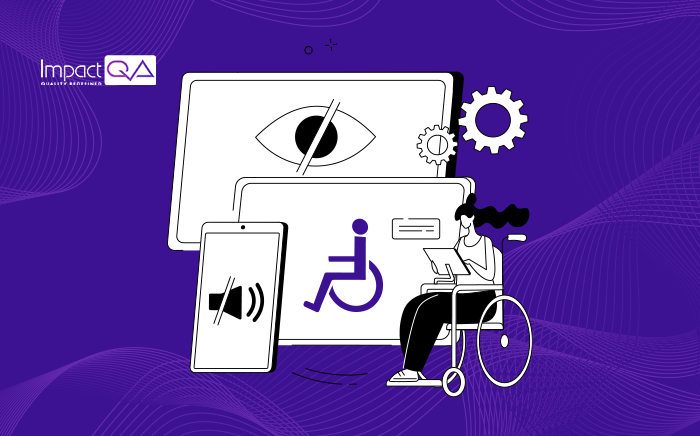Best Tools for Website Accessibility Testing in 2023

Most websites have some accessibility barrier that makes it difficult for people with disabilities to use. Accessibility testing ensures that your website is accessible to all, including people with disabilities with vision, hearing, physical, speech, cognitive, language, learning, and neurological. On a broader front, website accessibility testing is part of the usability testing process.
What is Accessibility Testing?
The process of accessibility testing basically involves reviewing your application, website, or other forms of digital content using common standards. The fundamental goal is to make technology accessible to everyone, especially people with impairments such as hearing loss, color blindness, and other disadvantaged populations. Accessibility testing can be seen as a subset of Usability Testing.
Accessibility testing can be performed in two ways- Manual Testing and Automation Testing. This particular testing process can be conducted by two groups of individuals, namely, experts and users.
Expert testing covers inspecting the software application or website based on operability, assistive technologies, structural examination, and perception. User testing, on the other hand, is real people reviewing the software from the end-user perspective to identify faults.
List of Reliable Accessibility Testing Tools
To achieve quality testing of your website, you must have good knowledge of the right accessibility testing tools. But how do you determine which tool is appropriate per your website’s requirements?
There are a variety of factors that come into play, such as the site’s budget and overall user volume. Here is a list of the top manual and automated accessibility testing tools for website accessibility testing in 2023, along with their different features & functions that can help you judge better.
1. AChecker
- AChecker is one of the holistic web accessibility testing tools used to assess the HTML content for a single web page.
- You can test your web pages by uploading an HTML file, entering the URL, or pasting the source code straight into the tool.
- AChecker is ranked among the leading website accessibility tools that offer the option to evaluate the website using different accessibility guidelines, such as WCAG 1.0, WCAG 2.0, HTML Validator, BITV 1.0, and Section 508.
- This tool can be both used online and offline simply via installation.
2. WAVE
- It is a community-built free tool designed to facilitate web accessibility testing by offering developers a visual representation of problems directly on their page.
- WAVE is a browser-based tool that assesses issues ranging from color contrast to ARIA attributes and is based on compliance standards from Section 508 and WCAG.
3. JAWS (Job Access with Speech)
- It is the most popular Screen Reader tool for visually impaired customers. Some of the good features of JAWS comprise two multi-lingual synthesizers, Viz. Vocalizer Expressive and Eloquence.
- Its reputation as one of the best accessibility testing tools is because of its agility to work with Microsoft Office, IE, and Firefox, and it supports Windows with its touchscreen gesture.
4. Dynomapper
- Dynomapper is a Visual Sitemap Generator of 4 types – Circle, Tree, Folder, and Default. It evaluates the HTML contents of the site and can generate a sitemap from any URL.
- It imports XML files to generate the sitemap. It also provides content audit and inventory for filtering pages, images, and files.
5. aXe
- Like WAVE, aXe has extensions for Firefox & Chrome; however, the aXe extensions are more developer-focused. The aXe extension is an incredible tool for developers.
- If you are looking for an effective accessibility tool for websites, aXe is the ideal choice; that works on all modern browsers and supports static fixtures, in-memory integration tests, and iframes of infinite depth. It is designed to work with whatever libraries, frameworks, environments & tools you have today.
6. Siteimprove
- Siteimprove is a highly effective website monitoring tool for accessibility and quality assurance.
- The best thing about Siteimprove is that it offers a cohort of skilled accessibility testers who can deliver both manual and automated testing solutions.
- Through a team of accessibility testers, Siteimprove addresses Office of Civil Rights (OCR) compliance and successfully resolves OCR complaints.
- You can also access a thorough audit report outlining corrective measures and new content planning.
7. Equally AI
- Equally AI is regarded among the top-tier automated compliance testing tools for web accessibility. It is well-known for assisting users in ensuring their websites and apps comply with all legal requirements.
- The tool can offer a pleasant and reliable experience for disabled users.
- Equally AI provides a straightforward user interface with specific display options, making testing easy in different accessibility scenarios.
- The tool’s mobility solution allows you or your users to test the accessibility of your website using only a keyboard.
- Equally AI is managed by a dedicated team of testers, who ensure this tool is used correctly.
8. Google Lighthouse
- Google Lighthouse is an open-source platform that automates website accessibility testing through Google Chrome.
- This website accessibility testing software is available in Chrome Developer Tools and does not require additional extensions or configurations.
- Lighthouse performs various audits covering a wide range of WCAG requirements, such as missing alt text, lower color contrast ratios, and so on.
- This tool rates your website’s accessibility after each round of auditing and provides recommendations for improving it.
9. SortSite
- SortSite is a popular one-click user experience testing tool for Windows, Mac OS X, and Linux.
- The tool is fully compatible with desktop, Internet Explorer, and mobile browsers.
- SortSite evaluates your website’s accessibility following existing accessibility standards such as WCAG 1.0 85, WCAG 2.0 110, and Section 508 15 US 47.
- This tool is helpful because it efficiently checks for HTTP error codes as well as script errors. Additionally, it validates CSS, HTML, and XHTML.
10. UserWay
- UserWay is an innovative accessibility compliance tool that employs artificial intelligence to guarantee that the website or application provides a wonderful user experience to those in need of accessibility assistance.
- It can be quickly added to your website as a plugin to provide an aesthetically pleasing and user-friendly interface.
- By allowing you to move the widget and alter its size, position, or color, UserWay also lets you personalize the user interface.
- You can use UserWay to scan the websites and apps for violations of not complying with the legal requirements for accessibility.
Wrapping Up …
The purpose of website accessibility testing is to identify and correct all compliance issues. The tools listed above help improve the overall usability of your website or application to assist disabled users. You can try looking for credible accessibility testing services that can assist you in resolving various website accessibility issues. At ImpactQA, we manage an in-house team of certified accessibility testers who are there to take care of your project needs. As technology upscales, our testers remain up to date with new upgrades to ensure the website is accessible to all!




